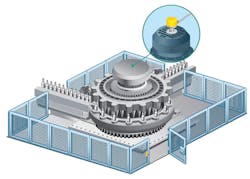Total shutdowns not needed with safety controls based on encoders
Factories usually put safety fences around sorters, fillers, and other rotating machines that pose a danger to workers. Gates in fences let operators and maintenance personnel into a machine’s workspace only when it’s safe. Typically, the worker hits a button that sends a request-to-enter signal to a timer. The timer counts down a preset wait period to give the machine time to come to a halt — even if it was not running at its fastest when the worker requested access. For added security the machine’s drive power is disengaged. Then the gate opens.
While effective, timer-based safety is inefficient because it results in unnecessarily long wait periods and safety margins to 50%. For example, if a machine coasts a stop in 30 sec (as it’s assumed a faulted system lacks the means to actively brake) the added safety margin results in a 45-sec wait period — even if the machine was running slowly and can still brake. This increases machine downtime and tempts frustrated operators to bypass the safety devices.
An alternative for rotating machines is to base safety controls on safety-rated encoders. Here, the encoder tracks system speed. When a worker needs to get close and triggers the request-to-enter signal, the controls slow the machine. As soon as the encoder detects that potentially hazardous motion has stopped, the gate opens.
In some cases, encoder-based safety eliminates the need to remove power from the drive: The safety encoders continuously track machine motion and trigger safety shutdowns if a faulty drive tries to start the machine while a person is near.
Safety encoders even mitigate machine runaways caused by drive failures if the drive is programmed with bad limits, if the range of movement is incorrectly set, or if there are bad references in the motion program. Runaways are dangerous to operators. They also necessitate costly repairs when they cause crashes. Safety encoders can detect overspeeds before a machine goes out of control; then the controls initiate a machine shutdown.
One caveat: Machine-safety systems must incorporate redundancies. Conventional safety devices such as e-stops, for example, have redundant contacts. In contrast, encoder-based safety uses redundancies programmed into a speed-monitoring module. Here, programmed-in logic activates safeguards in response to encoder pulse counts that represent overspeeds and stops. Some setups verify the direction of rotation — useful in applications that can only turn safely one way. Here, if the encoder detects the machine is spinning the wrong way (as the result of a drive failure or PLC programming error) the controller will shut the machine down.
Helge Hornis at Pepperl+Fuchs provided information for this column.

